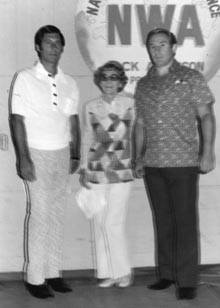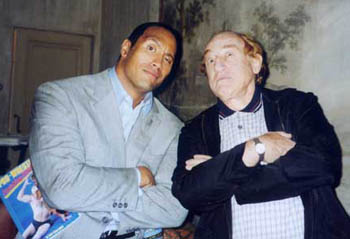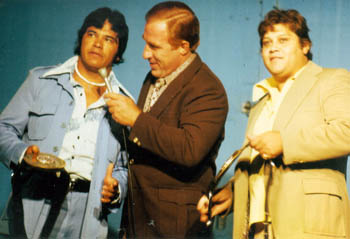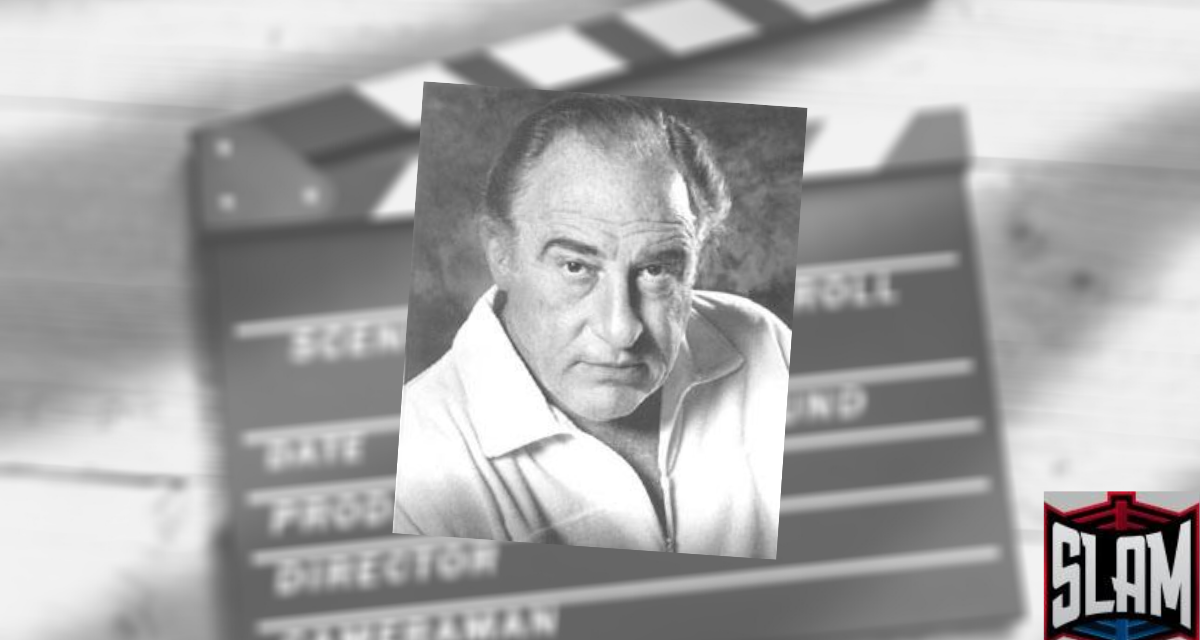If there’s one lesson to take from Francis Ford Coppola’s celebrated mafia trilogy, it’s that when the Godfather talks, you listen. So it is that when the Godfather of Grappling — the legendary “Judo” Gene LeBell — is willing to take Slam Wrestling on a tour through his career in the ring and doing stunt work in films that men half his age would shy away from, careful attention must be paid.
What emerged after speaking with LeBell and two of his fellow wrestlers-turned-actors was the portrait of a man who stands up for his friends, for passionate work, and who hides a caring nature underneath a rough-and-tumble exterior.
“Once in a while it’s nice to be able to take care of yourself,” LeBell states matter-of-factly, providing an understatement concerning his credentials in the professional fighting world. LeBell defines his first love, grappling, as a combination of styles as diverse as Greco-Roman and freestyle wrestling, judo, boxing, and more. Ed “Strangler” Lewis introduced LeBell to grappling, teaching him the barbaric beauty of a sport in which you could “hit someone in the mouth and go into a front-face lock — legally,” as LeBell describes it.
The future Godfather met the Strangler while LeBell’s mother, Aileen Eaton, ran the operations of the Los Angeles Auditorium. Since she booked legendary boxers such as Muhammad Ali and Joe Frazier, along with equally luminary wrestlers John Tolos and Andre the Giant, she gave her son an advantage in growing up with magnificent talents from these different disciplines surrounding him. It was therefore only logical that he would find his way into some facet of the fighting or entertainment business at some point (Gene’s brother, Mike, would run the Los Angeles wrestling territory as well).
He tried many different roads with his various skills, rubbing shoulders over the years with a roll call of people that reads like a hall of fame induction list: Mike Mazurki, Mando Guerrero and Lou Thesz are names that come off the top of LeBell’s head, hearkening back to a different era in pro wrestling.

A rare photo from 1973 of Mike LeBell, Aileen Eaton and Gene LeBell. Photo by Mike Lano.
It’s an era that LeBell misses. “You have to have show business now,” he states. “You look at Lou Thesz — he never over-acted and he always went for the finishing holds — and they believed it. When I first went to Japan and saw some of the superstars from over here clowning around, the audience said ‘no way.’ We want something than we can believe.”
LeBell never had any trouble with people disbelieving his fighting prowess. In judo, he claimed National Judo Heavyweight Championships in 1954 and 1955. In amateur wrestling, LeBell’s record is a little harder to quantify since he doesn’t count his disqualifications as losses — and there were many disqualifications.
“I spent my life doing grappling, which is illegal,” he explains. “So when I wrestled amateurs I’d either win or get disqualified.” In the crowning moment of his career in professional wrestling, however, LeBell managed to both win and get disqualified in the same match. After taking the heavyweight title from Australian Pat O’Connor in Amarillo, Texas, LeBell got a little carried away and swung the belt around in celebration. He clocked the commissioner on the head with the belt and was abruptly stripped of the title. Still, he had reached the top of yet another mountain (albeit briefly), and LeBell looked for a new challenge. He found it in Hollywood.
LeBell has been recognized in the past as a “Reel Honouree” by the Cauliflower Alley Club, an award bestowed upon him for an endless array of credits in acting and stunt work (he also received the CAC’s top honor, the Iron Mike Mazurki Award, in 1995). As with others that have made the transition from squared circle to silver screen, LeBell considered the business in the ring and in front of the camera to be complimentary, and he offered some insight as to why there has been such a legion of talent able to cross over in both directions.
“A lot of the pros do so well because they’re used to the interviews and they can do dialogue so easily — it doesn’t intimidate them,” he surmises. “Wrestlers are easy to work with, they do what you say because there’s no ego.”
Wait — no ego amongst wrestlers?
To clarify, LeBell defines ego in wrestling and ego in Hollywood as different entities. “In the film business, everybody’s trying to get the jobs, and if there’s a good script, and a big budget, movie stars will try and get on it,” he suggests. “It’s not physical, but they do whatever they can politically.”
This aspect of playing such mind games within the film business seems to rub LeBell the wrong way, and it’s no surprise for a man who has always been accustomed to handling problems with his bare hands. If anything, LeBell uses his political clout to help people, not hold them down.
As one of many who credit LeBell with helping to find their way from headlocks to Hollywood, “Wildman” Jack Armstrong says that LeBell’s capacity for helping others is a big part of his legacy.
“I think he actually works harder for his boys than for himself,” Armstrong suggests. “He’s a very giving guy, which people don’t know because he’s a tough guy. But when he takes you under his wing, you’re flying. Some guys want to take advantage of him because he’s a nice guy, but the smart guys are the ones that learn from Gene. He’ll teach you stuff like not to rush on the show.”
Not rushing on the show must be part of a commitment to getting the job done just right … right? “No, you’ll get double-time if you stay another two hours,” laughs Armstrong.
As for the politicking in pro wrestling: “The difference is you can get hurt,” LeBell explains succinctly. “If a guy doesn’t like you and he’s a better wrestler than you, he beats the crap out of you — and I’ve seen that many times. But if you can wrestle, really wrestle, you don’t get hurt nearly as much.”
As previously mentioned, LeBell hails from a time when being able to “really wrestle” was the chief commodity for achieving success. He adds his voice to countless others that look back fondly on a bygone era. “I’m from the old school, and I like people that can wrestle,” he says. “If you have a little charisma, that’s a plus. But clowns that just make an abortion out of wrestling, they can’t be my heroes.”
However, one can’t deny that it’s exactly this mixture of showmanship and athletic ability that has enabled LeBell and others like him to craft lengthy careers spanning various fields of entertainment. Every wrestler must be in part a showman, and it is clear that LeBell is simply of the opinion that most pro wrestlers today lean too heavily towards the showmanship.

LeBell raises eyebrows with The Rock.
Of course, he has some favourites in the modern era, including one whose Hollywood success has already reached the upper atmosphere: The Rock. “I wrestled his father and his grandfather. He is a showman but he is great,” he says with legitimate enthusiasm. “More power to him because he’s a good guy.”
Impressive as The Rock’s success has been, however, he’s still a potential flash-in-the-pan when compared to LeBell as you look at his whole career. While amassing an amazing range of credits that has allowed LeBell to be a part of such seminary films as Raging Bull and a host of Carl Reiner comedies (including The One and Only), he attributes his success to an unlikely and self-deprecatory feature: “I’ve made a lot of money in the movie by being ugly, not by being pretty,” he laughs. “If there’s a pretty guy, they don’t want to beat them up in the movies. Even when I was younger, if they wanted to beat me up, I had to wear a mustache or a scar, so the audience doesn’t feel sorry for me.”
And you wouldn’t be out of line feeling sorry for LeBell if you caught sight of him doing some of his stunt work. Taking falls, crashing cars and motorbikes, being set on fire — it’s all in a day’s work. Of course, let’s not beat around the bush: for LeBell to be so involved in this line of work at his age is remarkable (LeBell was very reluctant to speak of his age, so I’ll simply say he’s in the high double-digits … the man knows where I live).
Scott L. Schwartz, another wrestler-turned actor that owes LeBell for helping to get his foot in the door, has the utmost respect for LeBell’s workrate in the stunt world.
“Gene has no fear,” Schwartz says, indicating what he believes to be LeBell’s greatest asset. “There are a couple of guys who can play a senior citizen walking down a hall, getting knocked into a wall, but nobody in the business will take it to the level that Gene does. I can still see him at a hundred years old in a wheelchair, getting knocked down three flights of stairwells, laying still until they call ‘cut’ and then he’ll dust himself off and go do it again.”
Armstrong has a similar suggestion as to how LeBell has accomplished everything he has: “He’s a fanatic,” he says. “Gene always delivered. He still delivers.”
All of this has helped create the legend that is Gene LeBell in the stunt business. “In North America, I’m as well known as any guy,” he explains. “That doesn’t mean I’m the best stuntman, just that I’m known more than the others. I’ve been doing stunts for 50 years, and there are a lot of great stuntmen a lot better than me, but I work a lot because people know me and like me.”

Gene LeBell interviews Chavo Guerrero Sr., left, and Raul Mata after they won the America’s Tag Titles in Los Angeles in 1975. Photo by Mike Lano
He also works a lot because stuntwork requires trust above all else, and anyone who’s achieved success in the wrestling world lives by the same credo. Schwartz also has this most high compliment to pay LeBell: “When Gene’s working, you’re safe,” he says. “Nobody’s going to get hurt. He doesn’t just worry about his own safety, he worries about everybody’s safety, and if something is too dangerous, Gene will not indulge in it.”
There was one much-publicized incident of an actor getting hurt that LeBell had a ringside seat for: Man on the Moon. “I’ve worked on series where the star had too much of an ego to let the stunt guy do it, and the star got hurt and closed down the show,” he says. In this case, he doesn’t name Jim Carrey as that person, but he does say this: “I said to Buddy Joe Hooker (stunt coordinator for Man on the Moon), ‘the guy’s not a wrestler.’ But he went out and did it anyway, and you know how bad they wanted publicity, and they got some good copy on it.”
Speaking of good copy, as soon as LeBell learns that I’m calling from the good-looking side of Niagara Falls, he goes on to share some “Canadian Content” material.
“My wife was born in Canada,” he tells me before going on to proclaim a certain respect for Canada and Canadian wrestlers. “There are some good wrestlers from Canada — Gene Kiniski and all the Harts were good wrestlers,” he notes. “The father was good, the sons are good.”
He also attributes his continuing good health in part to “the clean living in Vancouver.” As for films in Hollywood North, he remembers having fun on Rat Race, for which he was the second unit director but didn’t have too long to strut his stuff on-screen. “The only time you see me is when I play an old man in a home,” he laughs. “One of the comedians dresses up like Hitler and I try and shoot him, and they carry me away.”
As you scan down his list of credits, you’ll see that LeBell often plays “Referee”, “Guard”, or some such tough-guy role. In real life, it’s LeBell’s role as teacher at his school for grappling in California that gives him the greatest sense of satisfaction and fulfillment. “It gives me a feeling of well-being to take a guy in and instead of him being a hoodlum, he ends up being a credit to society, which I think is very important, especially in L.A.,” he explains. “Anyone can walk across the Mexican border, and often they don’t speak English. That doesn’t mean they’re bad, but a lot of them don’t have jobs so they steal for a living or whatever they have to do to survive.”
Hardly a politician’s delicate speech, but it’s not LeBell’s intent to keep his feelings and opinions hidden. “I feel I help society and I help the individual. If a guy comes in with an attitude, I give him an attitude adjustment. He either changes or he doesn’t come back. You don’t want to teach anybody to fight that’ll just go punch people out in a bar.”
Thankfully, LeBell is more than a hoodlum or a bully, and he has used his skills for admirable purposes in teaching and helping to forge paths for other wrestlers to find their way into the film business.
His legendary status in the film world is built upon his role as an integral part of a film’s structure, one that doesn’t garner as much recognition as the actor, writer or director, but rest assured, many sequences just wouldn’t be possible without LeBell’s expertise and fearlessness.
So the next time you see a film featuring a red-haired “senior citizen” taking a tumble down an apartment fire escape to the street below, remember it’s probably Gene LeBell, so not only was he unhurt — he probably got up and did it again.
RELATED LINKS
- Oct. 11, 2022: Friends, disciples say goodbye to Judo Gene LeBell
- Aug. 10, 2022: Mat Matters: Gene LeBell, dead at 89, was an old softie
- Aug. 10, 2022: Guest column: What was it like writing Gene LeBell’s book? Squirrely
- Aug. 10, 2022: Wrestling, MMA, movie worlds pay tribute to Judo Gene LeBell
- Nov. 24, 2009: Los Angeles promoter Mike Lebell dies
- www.genelebell.com
- The Cauliflower Alley Club

